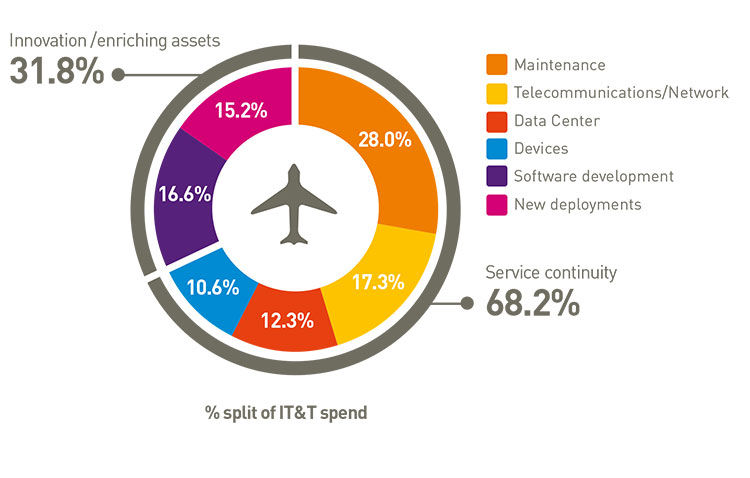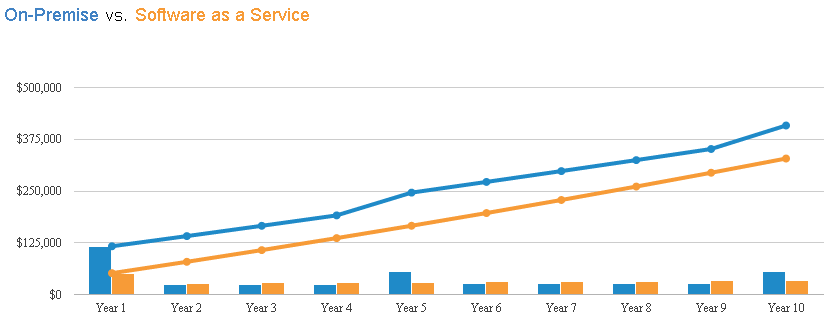SaaS on the Cloud vs in-house, on-premise approach in airline business
- Mar 1, 2019
- 4 min read
Updated: Mar 19, 2021

Cloud-based applications are quickly spreading across many areas.
The Cloud combines networks, servers and applications in a shared pool, generating huge efficiencies of scale. Companies and people can rent services hosted on the Cloud, that are customized to their particular needs. Software as a Service (SaaS) is a term specifically used for business solutions which are provided on a subscription-based model, accessed through a web browser and maintained and stored at the service provider data center or on the Cloud.
A couple of years ago, I was asked by a senior executive why his company couldn’t develop the same system that I was offering, and host it on their premises, instead of paying me forever a monthly fee for my SaaS solution. I told him that I had no doubt he could develop the software with his IT teams and host it on-premises, but there were some quite important issues he needed to take into account first…
Many businesses greatly underestimate the effort it takes to host software on premises, let alone develop and maintain a whole solution by themselves. This effort is especially big in the commercial areas (for example, in pricing, revenue management and network functions) and operational areas of the airline industry, where on-time demands can collapse an IT department’s capability to respond and to innovate.
The SITA IT Trends Survey 2015 states that “airlines are beefing up data collection and processing to provide frontline staff with the right information at their fingertips”:
75% of airlines will run programs in airline business intelligence in the next three years.
68% of airlines will invest in data centers for security and robustness of information.
57% of airlines use SaaS today.
88% of airlines are to use SaaS by 2018.
Source: SITA IT Trends Survey 2015
These figures call for questioning. The same survey shows that 68.2% of airlines’ expenses in IT are focused on service continuity, while only 31.8% is given to innovation and enriching assets such as software development and new deployments. It seems that airlines’ IT budgets are getting sucked by the need to maintain costly legacy technologies.

Source: THE AIRLINE IT TRENDS SURVEY 2015 | © SITA 2015
To reach 88% of SaaS use by 2018, one may wonder whether those investments are sufficient, or if executives are taking the leap forward on time. Timing is essential: the new market scenario that airlines are facing since a few years ago, is generating huge pressure from consumers and corporate customers, increasingly empowered by on-line travel agencies, social networks and internet technologies. The airlines, stuck in legacy technologies, are suffering of an increasing disadvantage against the consumers and the market forces.
The additional budget needed for innovation in this new scenario should come from dramatically reducing the cost of legacy technologies. This could be achieved by replacing on-premise infrastructure and software for SaaS solutions, replacing data centers for Cloud, and replacing in-house software development for specialized supplier software. Regarding the IT talent necessary to sustain an in-house, on-premises approach, it is no secret anymore that corporations around the world are having huge difficulties finding and hiring good IT talent: talented IT professionals just want to work for innovative and dynamic tech companies, where technology and software development are the core business.
Some important advantages of SaaS on the Cloud over legacy approaches
1. Economies of scale of the Cloud translate into much lower TCO (Total Cost of Ownership)
SaaS companies have mastered the use of the Cloud to make the most cost-efficient possible use of the huge amount of hardware available, transfering the “pay per use” scheme of the Cloud directly into cost savings for their customers. One of the biggest impacts of this is that with SaaS, no hardware investments are required.
2. SaaS delivers fast and lean innovation
A second benefit associated with SaaS is that innovation can be done at a much lower cost, faster pace and with much less risk: hardware improvements on the Cloud can be immediately tested and taken advantage of by SaaS companies to improve their service. On the other hand, software upgrades may be performed in an incremental, low cost, not invasive, high frequency fashion. These are huge advantages and, at the same time, they may explain why many corporate IT departments still look at SaaS with suspicion: almost no involvement of local corporate IT resources is required to implement and maintain a SaaS platform.
3. Experience curve for specialized SaaS companies raises much faster than for in-house, on-premise platforms
Given the pace and nature of the innovation enabled by the SaaS paradigm, after developing and maintaining their platform for a couple of years, a SaaS company typically has been able to incorporate massive improvements to their solution and has gained a huge accumulated experience. This position is practically impossible to match by a corporation using local, legacy IT paradigms.
4. SaaS providers offer accountability and low exit barriers
If a corporation fails in its attempt to locally develop an IT solution, or if an on-premise platform managed by a local IT team doesn’t meet the expected levels of service, there is not much the corporation can do about it, except for trying to do better next time and promptly recognizing a loss of financial and human resources invested. However, the most important loss associated to a failed innovation initiative, is the invaluable time to market lost against competitors. In opposition to this, usually a SaaS solution gets implemented much quicker than an on-premise solution, you can very soon make sure that it reallly works and delivers the right service levels and, in case it doesn’t deliver what was expected, usually you can stop the contract with low exit costs; basically, somebody gets punished!
On-premise vs. SaaS expenses

Source: Softwareadvice.com
5. SaaS helps corporations free resources to focus on their core business
If you have your teams and talents dedicated to the generation of profits from your core assets and identifying and selecting the right innovation opportunities for their core processes, instead of having them leading local software developments and managing on-premise platforms, you are probably going to have a more focused, more innovative, more profitable and happier team.
These are only some of the benefits that SaaS offers to an airline. Nonetheless, this is the tip of the iceberg for an ever-growing range of business solutions that helps you focus in your core business, providing you with the right insights and a better time to market.
What concerns would you have before choosing a Cloud based SaaS platform as a core commercial system for your airline? What about a pricing intelligence system? Your opinions are crucial so we can offer you the best service adapted to your needs. I appreciate your comments below.




Comments